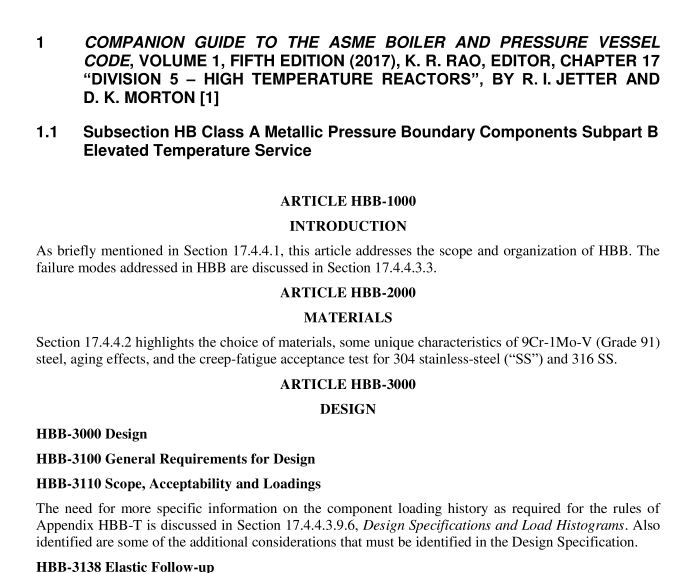ASME NTB-2:2019 pdf free download Background Information for Addressing Adequacy or Optimization of ASME BPVC Section III, Division 5 Rules for Metallic Components
Representations of creep data are also illustrated,including the effect of hold times at constant strain oncyclic life.This is a broad-brush treatment that sets the stage for further detailed discussions.
HBB-3214.2 Inelastic Analysis
Inelastic analysis may be required to satisfy strain limits and creep-fatigue damage evaluation; however,only general guidance is presented in HBB-3214.2,however,specific guidance was provided for earlyliquid metal fast breeder reactor(“LMFBR”) programs. Section 17.4.4.3.9.4, Inelastic Analysis Methods,provides an overview of that guidance.More details on the early guidance are provided in WeldingResearch Council, Inc.(“”WRC””)Bulletin 365,Volume IlI- Inelastic Analysis, July 1991, as discussed inSection 3.3 of this background document.
HBB-3220 Design Rules for Load Controlled Stresses in Structures Other than BoltsHBB-3221 General Requirements
Allowable stress criteria for Design Limits are discussed in Section 17.4.4.3.5.1 and criteria for ServiceLimits in Section 17.4.4.3.5.2.As discussed above, how the limits on loading and material response atelevated temperature are classified into load-controlled and displacement-controlled quantities is discussedin Section 17.4.4.3.4,Stress and Sitrain Categories and Controlled Qucntities. Also shown inSection 17.4.4.3.4 is the flow diagram for elevated-temperature analysis, Figure HBB-3221-1, that replacesthe hopper diagrams used to illustrate the sequential application of the design rules below the creep regime.weld metal rupture strength factors are discussed as well in Section 17.4.4.3.5.2.
HBB-3222.1 Design Limits
Section 17.4.4.3.5.1 describes the limits for Design Loadings, which are analogous to the allowable stressvalues in BPVC Section I and BPVC Section vmI, Division 1.
HBB-3223 Level A and B Service Limits,HBB- 3224 Level C Service Limits, and HBB-Level DService Limits
The limits for the primary membrane portion of the combined membrane and bending loading inHBB-3223,HBB-3224, and HBB-3225 are described in Section 17.4.4.3.5.3.The limits for the primarybending portion of the combined membrane and bending loading in HBB-3223,HBB-3224, and HBB-3225are described in Section 17.4.4.3.5.4.This also includes the rationale for the bending stress load factors thataddress the reduced load carrying capacity in bending with creep as compared to the ideal elastic-plasticdistribution applicable below the creep regime. Section 17.4.4.3.5.5 discusses the use fraction approach toaccount for a component not operating at a single temperature and/or primary load level throughout itsoperating history. The applicable code paragraph for use-fraction is HBB-3224(b).
HBB-3227.8 Cladding
Although cladding is not addressed in Chapter 17 of the Companion Guide, it is included here as an itemof interest for proposed molten salt reactors. The current rules provide limited requirements on primarystress limits(i.e., no credit for cladding strength) and similarly limited requirements for deformation-controlled limits (i.e.,cladding shall be considered for deformation-controlled limits) but no specificrequirements are defined. No additional cladding requirements are provided in Division 5 for fabrication,inspection, or testing.There is a recent technical paper by Messner et al, The Mechanical Interaction ofClad and Base Metal for Molten Salt Reactors, PVP2018-84101 [4], that addresses design issues with thegoal of improved code provisions for cladding.
HBB-3230 Stress Limits for Load Controlled Stress on Bolts
Section 17.4.4.3.9.2 provides the background for the primary stress Design Limits for bolts in HBB-3232,Service Level A and B limits in HBB-3233,Service Level C in HBB-3234, and Service Level D inHBB-3235.Also discussed are the rules for deformation-controlled stress and the special provisions inHBB-T-1721 and HBB-T-1722 for creep-fatigue damage evaluation.
ASME NTB-2:2019 pdf free download
